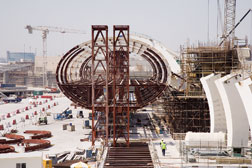 Michael Goodman/ENR Paving taxiways is a first step in $4.1-billion investment.
|
As if to acclimate visitors to Dubai’s construction boom, its international airport is a scene of intense activity. A new underground terminal and two concourses account for most of the $4.1-billion current investment there. But that is just a fraction of what the emirate plans to spend on airports by 2012.
“We have to set the stage for future growth,” says Khalifa Suhail Al Zaffin, the Dept. of Civil Aviation’s director of engineering and projects. The authority forecasts airline passenger numbers visiting Dubai rising from 25 million last year to 70 million in 2020.
Since it already can take 20 minutes to shuttle from the remote Terminal Two to the single concourse, DCA is in a hurry to relieve congestion with new facilities. For the longer term, it is starting construction at a potentially vast new airport ultimately able to handle 120 million people a year that will form part of a logistics city, near Jebel Ali port and free zone, about 50 kilometers down the coast from the city.
The Jebel Ali area “has a harbor, now it needs runways,” says Al Zaffin. Spread over 140 sq km of desert east of Jebel Ali, a new city is planned, including over $30 billion of investment on a business city centered on the airport.
The development’s $2.2-billion first phase, due to end in early 2008, includes Dubai’s 25-sq-km Logistics City, planned to handle 12 million tonnes of freight annually in 16 terminals. There will also be Residential City, Commercial City, a Golf Resort and initial elements of the airport itself.
The first of six runways is in early construction, while DCA plans a temporary terminal for up to 7 million passengers a year. “We want to tap into the low-price airline [business] to relieve pressure on Dubai Airport,” he adds.
 Al Zaffin
|
While earthmovers in the desert start the first phase, the new terminal a few kilometers from Dubai City looks almost complete. With its long vaulted roof, it resembles the precast concrete terminal 2E at Paris Charles de Gaulle Airport that failed in 2004 (ENR 5/31/04 p. 10). But Al Zaffin is not concerned. “It’s not going to break,” he says.
The Dubai and Paris terminals share an architect, France’s Paul Andreu, but have different designers and designs. In Dubai, Cairo-based Dar al-Handasah Shair and Partners is doing the structural engineering while its joint venture partner, Aéroports de Paris, is handling airport systems. The joint venture also is supervising construction.
Dubai’s new 950-m long, 670,000-sq-m concourse has a steelwork vault roof, with a changing profile. It spans from 70 m and 90 m and rises from 29 m to 42 m above ground. Set at 12-m intervals, the vault girders are up to 1.5 m deep and made of 3.2-centimeter thick steel.
The concourse is adjacent to the new Terminal 3, which is built entirely below ground because of limited space. Within a roughly 400 x 350-m concrete box, the 532,000-sq-m terminal covers six levels, descending 23 m below ground. It is founded on 8,500, 1.2-m-diameter piles and a foundation mat that is 2.5 to 2.8 m deep. Its walls are typically 1.5 m thick.
Starting con-crete construction in June 2002, the Al Naboodah-Laing O’Rourke joint venture reached substantial completion early this year, says Dar al-Handasah’s Uzair Wasif, the project’s deputy resident engineer.
Altogether, the project is consuming 2.4 million cu m of concrete of up to 12,000 psi strength, equating to 40,000 cu m a week, says Wasif. “There was some delay, but they completed the major work within schedule,” he adds.
Five workers fixing rebar for the underground construction were killed two years ago when a crane struck the cage they were on. But in over 18 million working hours since then, there have been no lost-time incidents, says Wasif.
 Michael Goodman/ENR |
 Michael Goodman/ENR Dubai airport terminal shares the same architect as Paris Charles de Gaulle, but contractors do not worry about design.
|
Concrete reached ground level around September 2004, allowing Cleveland Bridge Middle East Ltd. to start erecting 28,000 tonnes of steelwork in November 2004. It finished this March.
The Al Habtoor Murray Roberts Takenaka Joint Venture, meanwhile, began work on finishes and electrical and mechanical equipment. Subcontractor Al Abbar Group started installing aluminum and steel framing for the vault’s glazing in summer last year.
Now planned to open next year, the terminal project is about a year late, says Al Zaffin. “The reason has nothing to do with construction. It’s about acquiring land and what have you,” he adds. At the same time, “costs have gone up little...we can say 15 to 20%.”
Contracts are fixed price, lump sum, but in Dubai’s hot market, materials costs have risen sharply during the project. DCA hired U.S.-based Hill International to manage its claims, none of which have reached litigation, says Al Zaffin.
As the project winds down, piling has started on the airport’s third, 800-m-long concourse, also to serve Terminal 3. Cleveland Bridge is due to erect its vault, similar to Terminal 3’s, by 2009. By then, current work at Jebel Ali will be at an end, removing another bottle neck from Dubai’s strained transportation infrastructure.
 Full Dubai Coverage
Full Dubai Coverage  Photographer Michael Goodman's view of a Middle East Boomtown
Photographer Michael Goodman's view of a Middle East Boomtown The People Behind the Boom
The People Behind the Boom 
Post a comment to this article
Report Abusive Comment